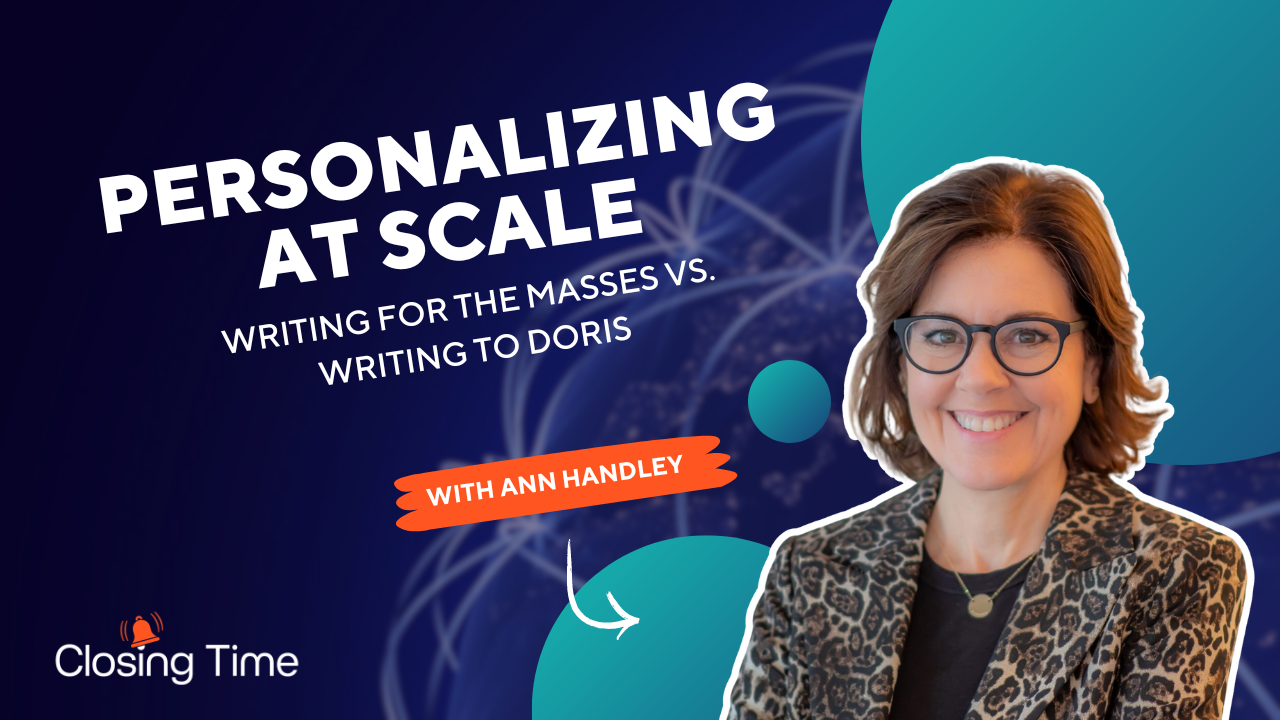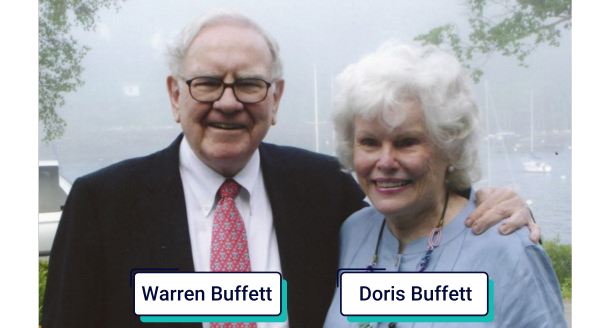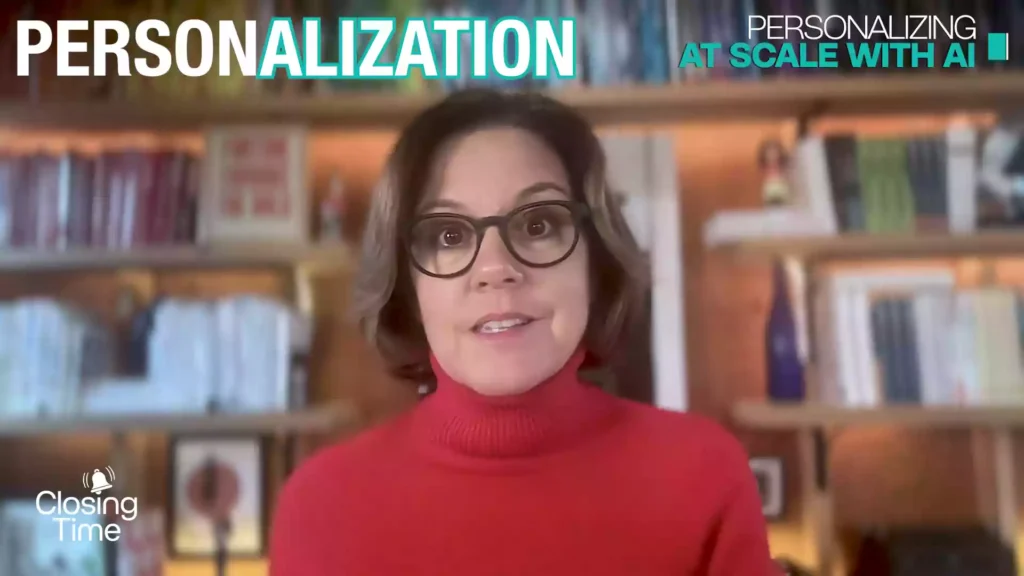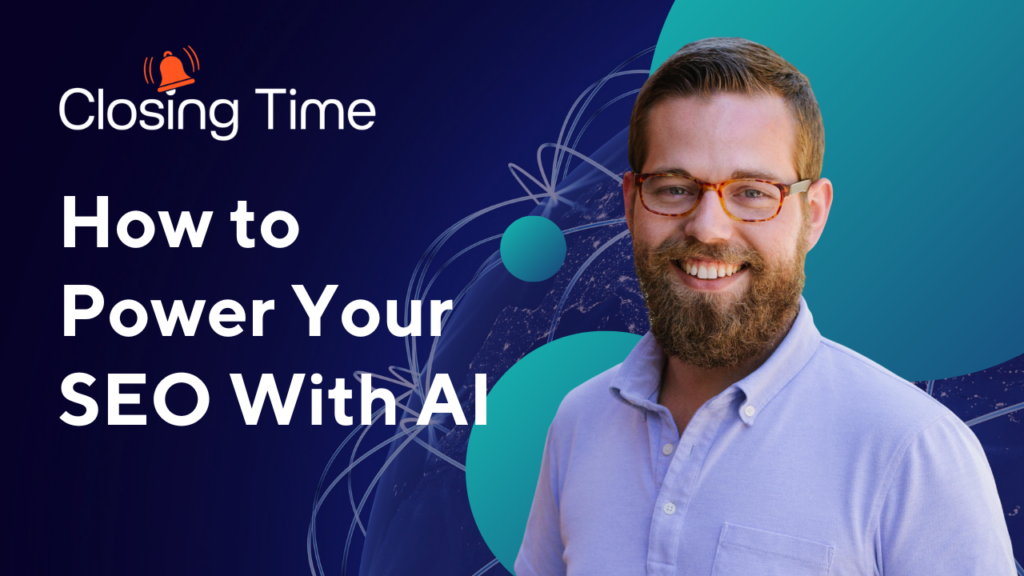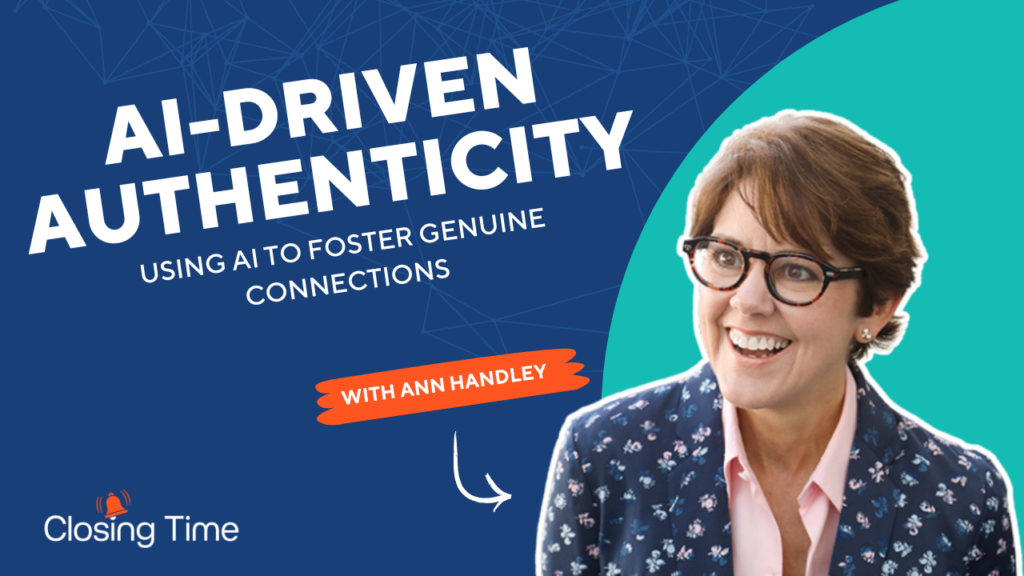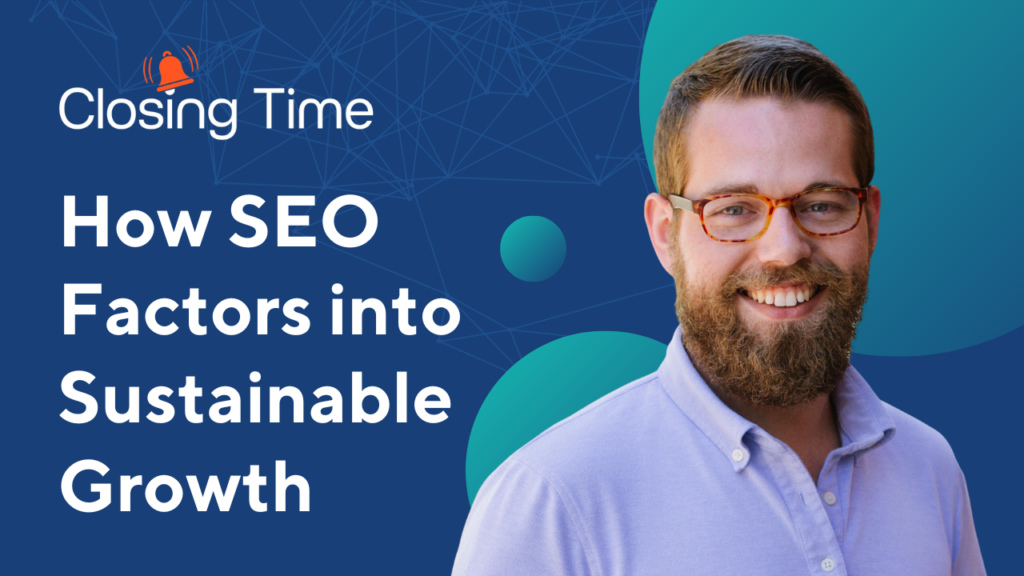Writing for the masses versus writing to one person.
Are they really all that different?
We’re going to meet Doris in today’s episode of Closing Time.
Thanks for tuning in to Closing Time the show for Go to Market Leaders.
I’m Val Riley, head of Content and Digital. Marketing and Insightly CRM.
Today I am joined by the one and only Ann Handley.
Ann helps businesses stand out in a sea of shame.
She is the world’s first Chief Content Officer.
A Wall Street. Journal bestselling author of three books,
and she has founded two multimillion dollar companies.
She’s a partner at Marketing Profs, an education and training company
that trains teams at the world’s most distinct businesses.
And inductee to the Content. Marketing Hall of Fame.
She’s also an avid collector of old school typewriters and a Tina Fey superfan.
Get ready. Here comes Ann Handley.
Thank you so much, Val.
That was a very generous introduction.
So it’s amazing to be here.
Thank you for having me.
Ann, we’re so happy to have you back on. Closing Time for a second episode.
And just to clarify, you’re Ann, I’m Val,
but we’re going to be talking about a lady named Doris.
And I hope people are following along.
So who exactly is Doris?
So, Doris, the legend of
Doris comes from a story
that I have told on stage many times.
Doris is the sister of the business icon. Warren
Buffett, and Warren Buffett, chairperson of Berkshire Hathaway.
Truly just a legend in business around the world.
And every year, Warren Buffett writes a letter to shareholders.
In that letter to shareholders, which comes out every February, I believe.
He talks about what’s on his mind,
what’s on the mind of business leaders.
What is boiling from a political, economic
standpoint, cultural standpoint, just all of it.
And what I love about his letter is that it is widely read.
Right.
You see it every February, written up in the financial news.
You’ll see it dissected everywhere because everybody wants to know, like,
what does Warren Buffett think about the state of the economy,
of business, of the world in any given year?
But what I love about that is that when Warren Buffett sits down
to write that letter to shareholders, that goes out to tens of thousands
of shareholders, that gets dissected by journalists globally.
He doesn’t think about all those people.
He doesn’t think about all those readers or all those interpreters.
He thinks about one person and he thinks about his sister, Doris.
And I think that writing to Doris
is a superpower for us as marketers.
Warren said that, you know, he doesn’t, she’s not an idiot.
She doesn’t want to be treated like a five year old.
But he has this great quote where he says,. I try to tell her what she needs
to know about the business if we sat down for an afternoon
and I think that we as writers, as
marketers can benefit from that advice because we do need to think about
who is our Doris like, who is the Doris that this email seeks to engage?
Who is the Doris that this social post seeks to connect with?
I think everything that we do,. Who is this Doris that this landing page
wants to convert?
Like, I think everything we do can benefit from that kind of mindset
because the reality, Val, is that
the more that you think about one person, the more universally it’ll appeal.
Which sounds paradoxical, but it’s 100% true
because it’s how you show up in the way that you connect
with your buyer, with your prospect, with your audience.
So Ann I have to admit, I’m a super fan.
I’ve seen you speak many times, and I have heard this advice before.
And when I’ve applied it in my own work,. I have to say it is amazing
how much differently you approach any type of writing, but especially email
when you’re just thinking about talking to that one person.
Yeah, exactly.. It changes the way you communicate.
I mean, listen, I do this.
Very often, my first drafts come across as not writing to Doris, right?
They’re kind of like dear valued customer or dear newsletter subscriber.
And I don’t know why I’m using. T-Rex hands, but I feel like I should,
you know, comes across very stilted and like very arm’s length.
But then when I go back and I read it a second time
and I just speak directly to Doris, you know, the Doris that I’m targeting
with this particular piece of content or the subscriber that I want to engage.
It just, it changes the way I communicate.
I just it makes my shoulders relax and
I just breathe out and I just act a whole lot more human
because ultimately, you know, that’s what we want to do, right?
It sounds so elemental. We are people.
We need to connect with other people, but yet somehow when we sit down
in a professional context, we kind of forget that.
And so writing to Doris
just reminds me of that constantly, and I’m glad to hear it reminds you to.
Yeah, and thank you for being so candid.
I think there’s this perception
when you get to a certain level, like you’re a chief content officer,
that the first draft is just gold, but really everybody has to write
and rewrite and edit.
Yeah, no, absolutely.
I mean, listen, my first drafts are spectacularly ugly.
I and I’m proud of that because the point is that, you know,
when I say ugly, I mean that like in a loving way, because I
you know, I’m proud of myself because I’ve gotten it out.
You know, it’s on the page or it’s on a screen.
I’ve gotten it out of my brain and I’ve translated it.
The more you polish it is, the better the product will be.
And so the difference between somebody who is a kind of mediocre writer
and somebody who produces something special, a lot of times that’s just adding
a little extra elbow grease and a little extra care.
Now, all that to say isn’t that we can take forever,
especially in marketing, like, you know,
I can’t take a week and a half to write an email newsletter like that.
Just is not realistic.
And so at some point you do have to ship, as Seth Godin says, right?
And so I do the best that I can up to the particular deadline that I have.
But the trick is like giving yourself a little bit of leeway
so that at least when you get there, you’re not publishing your first draft.
So progress, not perfection, is something that you know, we hear on our team
a lot and also ship it because sometimes you just have to let it go.
True.
And then let it go with love.. Like that’s what I always think.
It’s like I can really beat myself up,. I should have done that.
I should have like, had a better, you know,
I should’ve had a more clever metaphor.
I should have been a little looser.
I should have, like, really thought about what Doris needed for me.
Like all of those things.
But, you know, forgiving myself and letting it go with love
is also part of the process, too.
So, yeah, sometimes I feel with web copy, you know, they kind of beat it into us
that it has to be like super succinct and super short.
But sometimes that contradicts writing to a person.
How do you solve for that in some way?
Yeah, I mean, I don’t think of it as that we need to write short.
I think of it as we do need to make each word earn its keep.
You know, we need to make each word count.
We need to make each sentence actually play a role.
And as long as that is true, then I don’t worry
is as much about being succinct.
The thing that I do think is true, though, is when you’re writing for the web
or when you’re writing like even an email that you know somebody is going
to open up on a screen or
on their mobile
that, you know, you’ve got to make sure that it feels like it has some momentum.
And what I mean by that is you’ve got to carry the reader along, right?
Because the truth is, Val, that we are
just inundated with words constantly, all day long.
Right.
I mean, when after this
conversation with you,. I’m going to go back and open up my email
client and I’m just going to be like, like all of us every single day.
It’s just a deluge.
And so we’re all looking for a reason not to read.
And so I try to not give my reader
a reason not to read.
And by that I mean, you know,
just following some best practices around that, like writing shorter
sentences, not necessarily short length, but shorter sentences.
Long sentences are just hard to process on a screen.
And so, you know, keeping them short, that’s the world we live in,
using lots of white space, white space is oxygen.
I was reading an article earlier today and it was really, really good.
It was about storytelling and I was really into it.
But the paragraphs were, I’m not even kidding, like, and I was like,
Guys, I can’t.
And this is a subject. I’m interested in and I care about.
And I’m probably have more tolerance
than most people for chunks of gray text on a white screen.
But holy wow.
I mean, you’ve got to really think about the experience
that you’re delivering to your subscriber or to your reader.
And so, yeah, I think all that to say,. I don’t think it’s about writing short.
I think it’s about making sure that each word is there with intention.
I also feel that having white space, you know, as a reader
just lets me scroll, makes me feel like I’m
accomplishing something as I’m moving through a piece of content.
And so it makes me feel like. I want to continue to read.
So like, you know, maybe I’m just different or weird like that, though.
Well, I think that’s perfectly true.
Yeah.
I mean, I think you want to, my goal is often
to stop the scroll, you know, is to make it so compelling
that people want to slow down because they enjoy what I’m writing.
And I think that’s the kind of goal that I have in my writing.
I can’t measure it in any way, actually, probably some email clients
could or some email service providers could measure that.
But I mean, I don’t look at it so,
but just in my mind, that’s kind of what I want to happen.
Well, that’s a great transition to my next point, Ann,
you know,
because I’m sure there’s an AI tool that either does
that or is about to do that or someone’s working on it.
But when how does A.I.
interact with writing for Doris?
Do they contradict each other, or is there some symmetry there?
No, no, for sure.
I mean, like, look,. I think if anything, you know,
I talked to Chip in an earlier episode
around the notion that with a A.I., it’s never been easier
to create mediocrity at scale.
And I think that is very much why we still need to think about Doris.
I mean, if anything, Doris has a bigger role to play, not a diminished one.
And so, yeah, absolutely.
I think for sure she still matter.
She still applies.
So Doris is about writing to one person.
And, you know, with sales people, they want to personalize their emails,
but they really want to write to a lot of people.
So thinking about personalization at scale,
is that realistic or is it really just an oxymoron?
I think it’s a good goal to have as a marketer, but just to take a step back.
So think about like what does personalization actually mean, Right?
It’s the process of tailoring our marketing messages
in one way or another so that it truly connects with the recipient.
Right.
Or the individual who is either opening up a page
or opening up an email or whatever format that that content is taking.
My fear sometimes with personalization at scale
is that we tend to focus on the second half of that word. The
‘alization’ part of it.
Is that right? Yeah.
Instead of the ‘person’ we focus on the ‘alization’ part of it
because it seems like, oh, that just means that all we need to do is like layer
on some technology and automatically it’s like personalize like poof,
and it doesn’t really work that way.. I don’t think.
I think the best way
to think about personalization from a marketing standpoint anyway,
for most of us, especially in the B2B space, is to think about
what is our goal here?
Our goal is to connect with one person.
And so when you think personalization, remember that it’s so important
to think about the person before you hot glue on the rest of that word.
The ‘alization’ piece of it, right?
You know, in newsletters especially,. I talk a lot
about focusing more on the letter and less on the news.
In other words, we tend to think about kind of what
we want to say before saying it directly to one person.
And so I think the personalization angle is very similar to that.
Can you talk us through some types of tools or
maybe tactics where AI can help with personalization.
Right now, some of it is pretty good
in terms of allowing us to use
personalization in email and other
aspects of it are a little more uneven.
But one area where I do think that it can really help us in marketing
and sales is in, you know, in cold prospecting or cold emailing
where AI is pulling in some relevant information that’s allowing us to tailor
that outreach a little bit more robustly so that it does,
you know, connect with your customer or your target prospect.
So some of the AI tools that are out there now can look at
their past engagement history with you for sure.
They’re stage in the buying process,
the products or services that they care about based
on, you know, sort of what they’ve shared elsewhere, personal information
or things that they’re posting on social like all of that.
It can kind of aggregate and allow us to use the tool
to create more, more personal outreach to, you know, to have,
to hit those specific business goals that we have for our programs.
And so in that way,. I think it can be really, really helpful.
But remember that you always want a person at the center of that, right?
So don’t just create this stuff at scale and then just like blast it out.
Like, I really do believe that a person still has to touch each one of those
because the software isn’t perfect, number one.
But number two, again, it’s about the person.
It’s not about the ‘alization’ piece of it.
So I think we do have to make sure
that we are still at the center of that outreach.
So yeah, I think if there’s a direct response called outreach is a good use of it.
Newsletters, I think is a little trickier.
There are AI tools and capabilities out there that can help us curate content
for specific people who are on our list.
But I mean, maybe this exists.
Val I’m not sure, but I haven’t found a good AI tool that can actually,
you know, help outside of content creation from a newsletter standpoint anyway.
So that’s mostly what I’ve seen.
Well, I’m sure that’s coming next.
You know, I went to a big football school and a lot of times
I’ll get personalized outreach that, you know, references a cheer or something.
And I thought that was super unique.
And then I was talking to a friend who also went to a big football school.
And, you know, she gets that, too.
So like, it’s not super special.
You know, it’s something that we get a lot during football season.
I guess if you went, you know, she went to Penn State.
I went to University of Florida.. But like, it’s everywhere.
Right? Exactly.
And that’s like, you know, that’s a little bit of a party trick at this point.
Right.
So I think that’s what we’ve seen a lot of that up until now.
But where I am really excited and really interested in seeing this go,
is that okay, did that actually generate a response from you?
And if so, then what happens next?
You know, what happens after that?
You know,
are you feeling like they’re offering you a different kind of experience
when they’re using tools or do you start to just feel like,
oh, this is just like next level marketing automation, you know?
And I think that’s where it’s a challenge for us as marketers
to not let it just be that, but to use the opportunity
to create those connections with our audiences.
Because, you know, especially in email, that’s the name of the game.
It’s all about, you know, even in direct response emails, it’s all about
nurturing those relationships because you don’t want a one off, right?
You want to build loyalty and referrals or create
those connections long term, depending on the goals of your program.
But I think the more that we can remember that we need to use AI in those ways
and answer that question of what happens next, you know, it’s not just about making
you feel seen in that moment, but are they doing it consistently over time?
So yeah, I think that’s it’s
an interesting challenge and opportunity that we have in marketing today.
So in the nineties we had merge variables and we thought that was so cool.
And now today we have this whole new Pandora’s box to open.
I know it’s true, It’s true, it’s complicated,
but I also think it’s pretty exciting.
All right, Ann.. That’s all the time we have for today.
Appreciate you joining us.
Oh, my gosh, This was so much fun.. Thank you so much.
And thanks to all of you for tuning in to Closing Time.
Remember, you want to like this video, click
the button for notifications and subscribe to the channel.
That way you won’t miss an episode.
We will see you next week on Closing Time.

